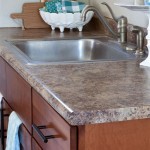How to Install a Wooden Countertop
Installing a wooden countertop can significantly enhance the aesthetic appeal and functionality of a kitchen or bathroom. While the task requires precision and attention to detail, it is a manageable project for homeowners with intermediate DIY skills. This article provides a comprehensive guide to installing a wooden countertop, covering preparation, installation steps, and essential considerations.
Planning and Preparation
Before embarking on the installation process, meticulous planning and preparation are crucial. This phase involves accurate measurements, countertop selection, and ensuring the substrate is adequately prepared to support the new countertop.
Measurement and Template Creation: The first step is to accurately measure the space where the countertop will be installed. Measure the length and width multiple times, ensuring consistency. Account for any irregularities in the walls or existing cabinets. If the countertop will have complex shapes or curves, creating a template is advisable. Use cardboard or construction paper to trace the desired countertop shape, accounting for overhangs and any cutouts for sinks or appliances. A precise template simplifies the cutting and shaping process.
Countertop Selection and Acquisition: Wooden countertops are available in various wood species, each offering unique characteristics in terms of appearance, durability, and cost. Popular choices include maple, walnut, oak, and cherry. Consider the existing décor and desired aesthetic when selecting the wood type. Also, factor in the countertop's intended use. For areas prone to moisture exposure, such as around sinks, select a wood species with inherent water resistance or plan to apply a water-resistant sealant. Purchase the countertop from a reputable supplier, ensuring the wood is properly kiln-dried to minimize warping or cracking.
Substrate Preparation: The substrate, typically the cabinet framework, must be level, stable, and capable of supporting the weight of the wooden countertop. Inspect the existing cabinets for any signs of damage or instability. Reinforce any weak areas with additional screws or shims as needed. Use a level to check the cabinet tops for levelness. If necessary, use shims to create a perfectly level surface. A level substrate is essential for preventing stress on the countertop and ensuring a professional-looking installation.
Tools and Materials: Gather all necessary tools and materials before starting the installation. These include:
- Wooden countertop
- Safety glasses
- Measuring tape
- Pencil
- Circular saw or jigsaw
- Router (optional, for edge profiling)
- Sander
- Sandpaper (various grits)
- Wood glue
- Screws (appropriate length for cabinet thickness)
- Drill with drill bits
- Level
- Shims
- Caulk (silicone or paintable)
- Clamps
- Finishing oil or sealant
- Clean cloths
Installation Process
The installation process involves cutting the countertop to size, fitting it to the substrate, securing it in place, and applying the final finish.
Cutting and Shaping the Countertop: Using the measurements or template created earlier, carefully transfer the dimensions onto the wooden countertop. Use a circular saw or jigsaw to cut the countertop to the desired size and shape. When making cuts, use a sharp blade and follow the cutting line precisely. For curved edges or intricate shapes, a jigsaw provides greater maneuverability. After cutting, use a sander to smooth any rough edges and refine the shape. If desired, use a router to create a decorative edge profile.
Creating Cutouts (Sinks, Cooktops): If the countertop requires cutouts for sinks or cooktops, carefully mark the locations and dimensions of the cutouts. Consult the manufacturer's specifications for precise measurements. Use a drill to create pilot holes at the corners of the cutout area. Then, use a jigsaw to cut along the marked lines. Take extra care to avoid chipping or splintering the wood. After cutting, smooth the edges of the cutout with sandpaper. Apply a sealant to the exposed edges of the cutout to protect against moisture damage.
Attaching the Countertop to the Substrate: Position the countertop on the prepared cabinet framework. Ensure it is properly aligned and centered. Use shims as needed to maintain a level surface. From underneath the cabinet framework, pre-drill pilot holes through the cabinet tops and into the underside of the countertop. Use screws of the appropriate length to secure the countertop to the cabinets. Avoid using screws that are too long, as they could penetrate the top surface of the countertop. Apply wood glue to the cabinet tops before screwing down the countertop for added stability. Use clamps to hold the countertop in place while the glue dries. A good rule of thumb is to place screws every 12-18 inches along the cabinet frame.
Sealing and Finishing: Once the countertop is securely attached, it is essential to apply a sealant or finish to protect the wood from moisture and stains. Choose a finish that is appropriate for the intended use of the countertop. For kitchen countertops, a food-safe finish is recommended. Options include mineral oil, beeswax, polyurethane, and epoxy resin. Follow the manufacturer's instructions for applying the chosen finish. Typically, multiple coats are required, with sanding between coats to achieve a smooth and durable surface. Apply caulk to the seam where the countertop meets the backsplash to prevent water from seeping behind the countertop. Let the finish fully cure before using the countertop.
Addressing Common Challenges
Several potential challenges can arise during the installation of a wooden countertop. Addressing these challenges proactively can ensure a successful outcome.
Warping and Cupping: Wood is a natural material that can be affected by changes in humidity. Warping and cupping can occur if the wood is not properly acclimated to the environment or if it is exposed to excessive moisture. To prevent warping, ensure the wood is properly kiln-dried and allow it to acclimate to the humidity levels in the installation area for several days before installation. Apply a sealant to all surfaces of the countertop, including the underside, to minimize moisture absorption. When installing, consider using slotted mounting brackets instead of directly screwing into the countertop. These brackets allow for slight movement in the wood without creating stress.
Seam Placement and Sealing: If the countertop requires multiple pieces to be joined together, seam placement and sealing are critical. Place seams in areas that are less likely to be exposed to moisture and stress. Use a high-quality wood glue designed for countertop applications to join the pieces. Clamp the pieces together tightly while the glue dries. After the glue has dried, sand the seam smooth and apply a sealant to prevent water from penetrating the joint. Consider using a color-matched epoxy or filler to fill any gaps in the seam. A well-executed seam should be nearly invisible.
Cutout Accuracy and Support: Precise cutouts are essential for proper appliance installation. Double-check all measurements before making any cuts. Use high-quality cutting tools and follow the cutting lines carefully. Provide adequate support for the countertop around the cutouts to prevent sagging or cracking. Reinforce the cabinet framework around the cutout area if necessary. Consider using support brackets or cleats to provide additional support. Proper support will ensure the longevity and stability of the countertop.
By following these guidelines, homeowners can successfully install a wooden countertop, adding beauty and value to their homes. Careful planning, attention to detail, and the use of proper tools and materials are essential for achieving a professional-looking result.

How To Install Butcher Block Countertops I Screwed Up A Little Youtube

How To Cut Install Butcher Block Countertops From A Z Youtube

How To Install Butcher Block Countertops Diy Kitchen Remodel

How To Install Butcher Block Counter Top Pro Tips

How To Install A Butcher Block Countertop Lowe S

How To Install Butcher Block Countertops Sew Woodsy

Installing Butcher Block Countertops Wildfire Interiors

How To Finish And Install Butcher Block Countertop The Crafty Blog Stalker

Diy Sink Install With Butcher Block Countertops Hardwood Reflections

Everything You Need To Know Before Install Wood Counters In Your Kitchen The Creek Line House
See Also








